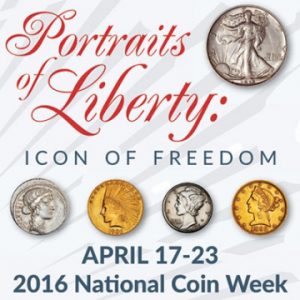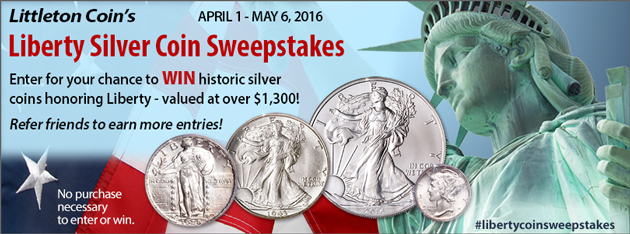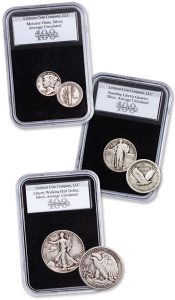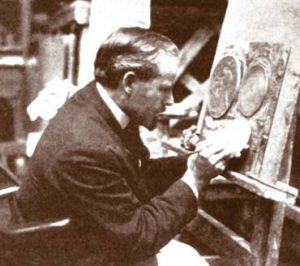National Coin Week honors the Liberty Design
Littleton Coin Company celebrates with the Liberty Silver Coin Sweepstakes
This year marks the 100th anniversary of three of America’s most beautiful and beloved coins – the “Mercury” dime, Standing Liberty quarter and Liberty Walking half dollar. All introduced in 1916, these three 90% silver coins featured a unique Liberty design for the first time, after sharing the same obverse motifs for over a century.
America’s first coin design competition
 Designed by prominent American sculptors in competition with other noted artists, each of these coins features an outstanding portrayal of Liberty – revered in circulation and collector favorites ever since. In fact, the “Liberty Walking” motif for 1916-1947 half dollars has remained so popular it was brought back on Silver American Eagles of 1986 to the present!
Designed by prominent American sculptors in competition with other noted artists, each of these coins features an outstanding portrayal of Liberty – revered in circulation and collector favorites ever since. In fact, the “Liberty Walking” motif for 1916-1947 half dollars has remained so popular it was brought back on Silver American Eagles of 1986 to the present!
Now, 100 years after their debut in 1916, National Coin Week from April 17-23 is honoring the centennial of these stunning designs. With the theme “Portraits of Liberty: Icon of Freedom” (National Coin Week) this annual event sponsored by the American Numismatic Association (ANA) will celebrate the various depictions of Liberty on coins and paper money from ancient times to the present day.

Enter our Liberty Silver Coin Sweepstakes from April 1-May 6, 2016
Celebrate the 100th anniversary of these beloved Liberty designs and win a Mint State set of silver U.S. coins valued at $1,300.00! No purchase necessary to win! Visit LittletonCoin.com/libertycoinsweepstakes for details.
Artistic coins with a deeper purpose
While the three Liberty designs introduced 100 years ago are highly acclaimed for their classic beauty and artistic excellence, each motif is also praised for representing the mood of the nation in 1916, as World War I raged in Europe and America hoped to remain neutral:
-

Special edition anniversary packaging honors the 100th anniversary with these Liberty designs; Mercury dime, Standing Liberty quarter and Liberty Walking half dollar.
“Mercury” Silver Dime – designed by sculptor A.A. Weinman, the Mercury silver dime of 1916-1947 is widely considered the most beautiful small-size U.S. coin. However, the obverse image of Liberty with a winged cap to signify freedom of thought and independence was mistaken by the public for the Roman messenger god Mercury. The reverse features a bundle of fasces (a Roman symbol of authority) and an olive branch of peace – representing America’s readiness to defend itself, but desire for peace. For more about these coins, see our Learn Center and our inventory of Mercury dimes.
- Standing Liberty Silver Quarter – this acclaimed design by prominent sculptor Hermon A. MacNeil depicts the full figure of Liberty standing at the “gateway of America” – bearing a shield with her left arm indicating preparedness for war and holding an olive branch of peace with her right hand, representing hope for peace. The eye-catching reverse of this 1916-1930 silver quarter features an American eagle in flight, symbolizing the nation’s dedication to freedom. Visit our Learn Center and see our inventory of Standing Liberty quarters.
- Liberty Walking Silver Half Dollar – also designed by sculptor A.A. Weinman, this 90% silver coin of 1916-1947 bears a magnificent full-figure image of Liberty draped in the Stars and Stripes and striding confidently toward the rising sun. In her left arm she holds a bundle of laurel and oak branches – symbols of civil and military authority. The equally impressive reverse features a powerful image of our national bird, the bald eagle, perched confidently, and even defiantly, upon a mountain crag. Discover more at our Learn Center and see our inventory of Liberty Walking halves.

Sculptor A.A. Weinman at his easel
These impressive designs recall circulating U.S. coinage before it featured portraits of prominent leaders like so many other coins throughout history. To reflect America’s new democratic form of government, first president George Washington did not want our coinage to resemble that of European monarchies by depicting leaders. His wishes endured for more than 115 years.
One by one, the designs of the Mercury dime, Standing Liberty quarter and Liberty Walking half dollar followed the precedent of the 1909-date Lincoln cent to feature revered American leaders. The quarter received George Washington’s likeness on the 200th anniversary of his birth in 1932, the dime took on Franklin D. Roosevelt’s portrait in 1946, and the half dollar was changed to Ben Franklin’s image from 1948-1963 and then to John F. Kennedy’s likeness beginning in 1964.
U.S. Mint to issue special 100th anniversary gold coins
To celebrate the 100th anniversary of Weinman’s and MacNeil’s great contributions to American coinage, the U.S. Mint will strike 24-karat (99.99% pure) gold versions of all three designs. Bearing 2016 dates, the anniversary Mercury dime will contain 1/10 ounce of gold, the Standing Liberty quarter will contain 1/4 ounce and the Liberty Walking half will contain 1/2 ounce. Special inscriptions on the coins will include au (the symbol for gold), 24k and the appropriate weight – 1/10 oz., 1/4 oz. or 1/2 oz.
Will MacNeil’s “scandalous” original Liberty design be replicated?
Many expect the 100th anniversary gold issue of the Standing Liberty quarter to replicate Hermon MacNeil’s original 1916 design – depicting Liberty with an exposed breast (Variety 1) and used until early 1917 when Liberty was “covered up” with chain mail (Variety 2) due to protests of immorality and desire for a more conservative image during the WWI era. At this time, I don’t know which type will be represented – but my hopes are that the 2016 anniversary issue will replicate the 1916 design.
The focus of National Coin Week
The popularity of MacNeil’s and Weinman’s Liberty designs are evident with the three special 100th anniversary issues and the attention on these coins during this year’s National Coin Week. These coins represent a unique era in coinage history, when talent outside the U.S. Mint staff was invited to design circulating coinage. And what results! I’ve had the chance to see many examples of Weinman’s and MacNeil’s silver classics by working at a coin company, but I remember well the thrill I got as a kid when I ran across an occasional Mercury dime or Liberty Walking half dollar in pocket change. These coins simply had a mystique and aura all their own!
If you remember or collect Mercury dimes, Standing Liberty quarters or Liberty Walking half dollars, please share with us why you like these coins – and enjoy National Coin Week from April 17-23.



